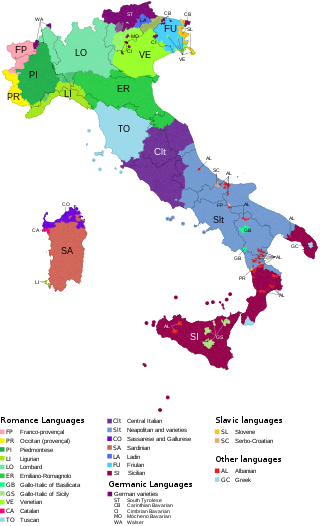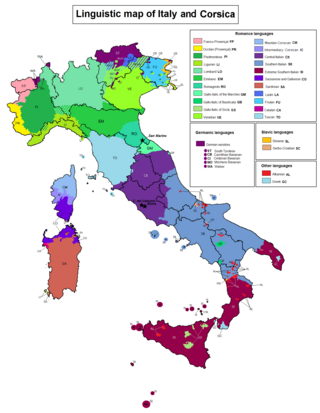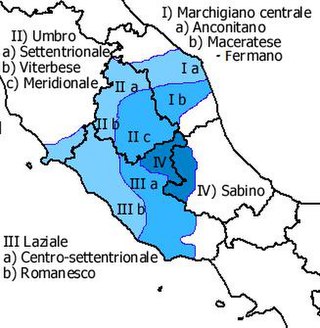Related Research Articles

Corsican is a Romance language consisting of the continuum of the Italo-Dalmatian dialects spoken on the Mediterranean island of Corsica (France) and on the northern end of the island of Sardinia (Italy). Corsican is related to the varieties of Tuscan from the Italian peninsula, and therefore also to the Florentine-based standard Italian.

Ticino, sometimes Tessin, officially the Republic and Canton of Ticino or less formally the Canton of Ticino, is one of the 26 cantons forming the Swiss Confederation. It is composed of eight districts and its capital city is Bellinzona. It is also traditionally divided into the Sopraceneri and the Sottoceneri, respectively north and south of Monte Ceneri. Red and blue are the colours of its flag.

The Lombard language belongs to the Gallo-Italic family and is a cluster of homogeneous dialects that are spoken by millions of speakers in Northern Italy and southern Switzerland, including most of Lombardy and some areas of the neighbouring regions, notably the far eastern side of Piedmont and the extreme western side of Trentino, and in Switzerland in the cantons of Ticino and Graubünden. The language is also spoken in Santa Catarina in Brazil by Lombard immigrants from the Province of Bergamo, in Italy.
Regional Italian is any regional variety of the Italian language.
Mario Alinei was an Italian linguist and professor emeritus at the University of Utrecht, where he taught from 1959 to 1987. He was founder and editor of Quaderni di semantica, a journal of theoretical and applied semantics. Until 1997, he was president of Atlas Linguarum Europae at UNESCO.

The languages of Italy include Italian, which serves as the country's national language, in its standard and regional forms, as well as numerous local and regional languages, most of which, like Italian, belong to the broader Romance group. The majority of languages often labeled as regional are distributed in a continuum across the regions' administrative boundaries, with speakers from one locale within a single region being typically aware of the features distinguishing their own variety from one of the other places nearby.

The Gallo-Italic, Gallo-Italian, Gallo-Cisalpine or simply Cisalpine languages constitute the majority of the Romance languages of northern Italy: Piedmontese, Lombard, Emilian, Ligurian, and Romagnol. In central Italy they are spoken in the northern Marches ; in southern Italy in some language islands in Basilicata and Sicily.
Western Lombard is a group of dialects of Lombard, a Romance language spoken in Italy. It is widespread in the Lombard provinces of Milan, Monza, Varese, Como, Lecco, Sondrio, a small part of Cremona, Lodi and Pavia, and the Piedmont provinces of Novara, Verbano-Cusio-Ossola, the eastern part of the Province of Alessandria (Tortona), a small part of Vercelli (Valsesia), and Switzerland. After the name of the region involved, land of the former Duchy of Milan, this language is often referred to as Insubric or Milanese, or, after Clemente Merlo, Cisabduano.
The primary languages of Calabria are the Italian language as well as regional varieties of Extreme Southern Italian and Neapolitan languages, all collectively known as Calabrian. In addition, there are speakers of the Arbëresh variety of Albanian, as well as Calabrian Greek speakers and pockets of Occitan.

Gallo-Italic of Sicily is a group of Gallo-Italic languages found in about 15 isolated communities of central eastern Sicily. Forming a language island in the otherwise Sicilian language area, it dates back to migrations from northern Italy during the reign of Norman Roger I of Sicily and his successors.
Bustocco and Legnanese are two dialects of Western Lombard, spoken respectively in the cities of Busto Arsizio and Legnano, Lombardy.
Comasco or Comasque is a dialect belonging to the Western branch of Lombard language, spoken in the city and suburbs of Como. Comasco is part of the Comasco-Lecchese dialect group.

The Italian language in the Italian Switzerland or Swiss Italian is the variety of the Italian language taught in the Italian-speaking area of Switzerland. While this variety is mainly spoken in the canton of Ticino and in the southern part of Grisons, Italian is spoken natively in the whole country by about 700,000 people: Swiss Italians, Italian immigrants and Swiss citizens with Italian citizenship.

Emilian is a Gallo-Italic unstandardised language spoken in the historical region of Emilia, which is now in the northwestern part of Emilia-Romagna, Northern Italy.

Cadorino, a dialect of Ladin, is the language of Cadore, at the feet of the Dolomites in the province of Belluno. It is distinct from neighboring dialects, and though it has received relatively little attention, it is important to an understanding of the linguistic history of northern Italy.

Italian irredentism in Switzerland was a political movement that promoted the unification to Italy of the Italian-speaking areas of Switzerland during the Risorgimento.
Piero Bianconi was a Swiss-Italian writer and academic.
Giovanni Orelli was a Swiss poet and writer who worked in Italian and the Ticinese dialect. His cousin Giorgio Orelli was a poet and literary critic.
Carlo Salvioni was a Swiss romanist and linguist.

The Central-Northern Latian dialect is an Italian dialect belonging to the Central Italian dialects, of which it represents the southern offshoot.
References
- ↑ "Population résidante permanente de 15 ans et plus, ventilée selon les langues parlées à la maison". Office fédéral de la statistique. Retrieved 13 August 2013. Multiple choices were allowed, up to a limit of 3 languages.
- ↑ Hammarström, Harald; Forkel, Robert; Haspelmath, Martin; Bank, Sebastian (2023-07-10). "Glottolog 4.8 - Piemontese-Lombard". Glottolog . Leipzig: Max Planck Institute for Evolutionary Anthropology. doi: 10.5281/zenodo.7398962 . Archived from the original on 2023-10-29. Retrieved 2023-10-29.
- ↑ "Lombardi, dialetti" [lombard dialects]. treccani.it.
A nord i dialetti definiti lombardo-alpini a partire da Merlo (1960-1961), parlati nell'Ossola superiore, nelle valli ticinesi a nord di Locarno e Bellinzona, nei Grigioni italiani e nell'alta Valtellina, caratterizzati da tratti arcaici e da una certa affinità con il romancio svizzero.
- 1 2 Biondelli, Bernarino (1853). Saggio sui dialetti gallo-italici (in Italian). p. 4.
Il dialetto principale rappresentante il gruppo occidentale si è il Milanese, e ad esso più o meno affini sono: il Lodigiano, il Comasco, il Valtellinese, il Bormiese, il Ticinese e il Verbanese.[...] Il Comasco esténdesi in quasi tutta la provincia di Como, tranne l'estrema punta settentrionale al di là di Menagio e di Bellano a destra ed a sinistra del Lario; e in quella vece comprende la parte meridionale del Cantone Ticinese, sino al monte Cènere. [...] Il Ticinese è parlato nella parte settentrionale del Cantone Svizzero d'egual nome, al norte del Monte Cènere, in parecchie varietà, tra le quali distinguonsi sopra tutto le favelle delle valli Maggia, Verzasca, Leventina, Blenio ed Onsernone.
- ↑ Jones, Mary C.; Soria, Claudia (2015). "Assessing the effect of official recognition on the vitality of endangered languages: a case of study from Italy". Policy and Planning for Endangered Languages. Cambridge, UK: Cambridge University Press. p. 130. ISBN 9781316352410. Archived from the original on 2017-04-21.
Lombard (Lumbard, ISO 639-9 lmo) is a cluster of essentially homogeneous varieties (Tamburelli 2014: 9) belonging to the Gallo-Italic group. It is spoken in the Italian region of Lombardy, in the Novara province of Piedmont, and in Switzerland. Mutual intelligibility between speakers of Lombard and monolingual Italian speakers has been reported as very low (Tamburelli 2014). Although some Lombard varieties, Milanese in particular, enjoy a rather long and prestigious literary tradition, Lombard is now mostly used in informal domains. According to Ethnologue, Piedmontese and Lombard are spoken by between 1,600,000 and 2,000,000 speakers and around 3,500,000 speakers, respectively. These are very high figures for languages that have never been recognised officially nor systematically taught in school
- ↑ Petrini, Dario (1988). La Koinè Ticinese. Livellamento dialettale e dinamiche Innovative (in Italian). Bern: Francke. ISBN 9783317016599.